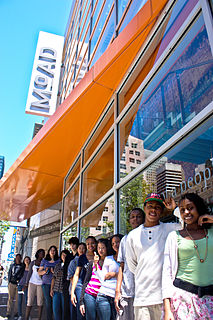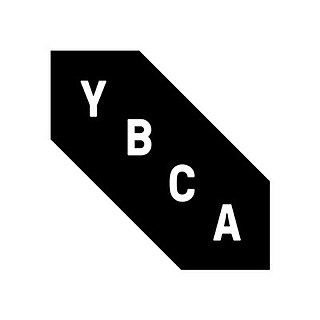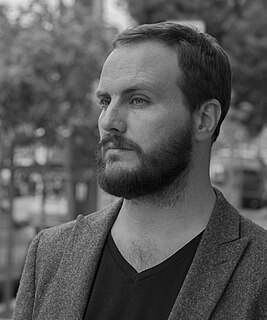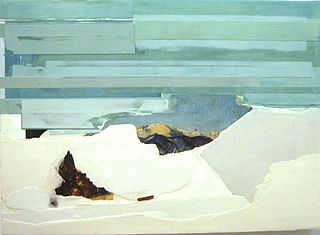Related Research Articles

Yerba Buena Gardens is the name for two blocks of public parks located between Third and Fourth, Mission and Folsom Streets in downtown San Francisco, California. The first block bordered by Mission and Howard Streets was opened on October 11, 1993. The second block, between Howard and Folsom Streets, was opened in 1998, with a dedication to Martin Luther King Jr. by Mayor Willie Brown. A pedestrian bridge over Howard Street connects the two blocks, sitting on top of part of the Moscone Center convention center. The Yerba Buena Gardens were planned and built as the final centerpiece of the Yerba Buena Redevelopment Area which includes the Yerba Buena Center for the Arts. Yerba Buena Gardens Conservancy operates, manages, programs, and elevates the property on behalf of the City and County of San Francisco.
Mowry Baden is an American sculptor who has lived and worked in Canada since 1975. He is known for his gallery-based kinaesthetic sculptures and for his public sculpture, both of which require a strong element of bodily interaction on the part of the viewer.

Ned Kahn is an environmental artist and sculptor, known in particular for museum exhibits he has built for the Exploratorium in San Francisco. His works usually intend to capture an invisible aspect of nature and make it visible.

The Museum of the African Diaspora (MoAD) is a contemporary art museum in San Francisco, California. MoAD holds exhibitions and presents artists exclusively of the African diaspora, one of only a few museums of its kind in the United States. Located at 685 Mission St. adjacent to the St. Regis Hotel in the Yerba Buena Arts District, MoAD is a nonprofit organization as well as a Smithsonian Affiliate. Prior to 2014, MoAD educated visitors on the history, culture, and art of the African diaspora through permanent and rotating exhibitions. After a six-month refurbishment in 2014 to expand the gallery spaces, the museum reopened and transitioned into presenting exclusively fine arts exhibitions. MoAD does not have a permanent collection and instead works directly with artists or independent curators when developing exhibitions.

Yerba Buena Center for the Arts (YBCA) is a multi-disciplinary contemporary arts center in San Francisco, California, United States. Located in Yerba Buena Gardens, YBCA features visual art, performance, and film/video that celebrates local, national, and international artists and the Bay Area's diverse communities. YBCA programs year-round in two landmark buildings—the Galleries and Forum by Japanese architect Fumihiko Maki and the adjacent Theater by American architect James Stewart Polshek and Todd Schliemann. Betti-Sue Hertz served as Curator from 2008 through 2015.

David Gilhooly, also known as David James Gilhooly III, was an American ceramicist, sculptor, painter, printmaker, and professor. He is best known for pioneering the Funk art movement. He made a series of ceramic frogs called FrogWorld, as well as ceramic food, planets, and other creatures.

Yerba Buena was the original name of the settlement that later became San Francisco, California. Located near the northeastern end of the San Francisco Peninsula, between the Presidio of San Francisco and the Mission San Francisco de Asís, it was originally intended as a trading post for ships visiting San Francisco Bay. The settlement was arranged in the Spanish style around a plaza that remains as the present day Portsmouth Square.

Joseph Thomas Del Pesco is a contemporary art curator and arts writer based in San Francisco, California. He is currently the Director of the Kadist Art Foundation in San Francisco.
Jesse Drew is an American artist, author, media activist, and educator.
Margaret Jenkins is a postmodern choreographer based in San Francisco, California. She was a Guggenheim Fellow in 1980 and in 2003, San Francisco mayor, Willie Brown, declared April 24 to be Margaret Jenkins Day.
Win "Winfred" Ng was a Chinese American artist, entrepreneur, and decorative designer. Ng was known for working as a ceramist, sculptor, metal worker, industrial designer, painter and illustrator, but best known as the co-founder of the groundbreaking San Francisco based department store Taylor & Ng and his commercial ceramics work under the same name.

Nick Cave is an American sculptor, dancer, performance artist, and professor. He is best known for his Soundsuit series – wearable assemblage fabric sculptures that are bright, whimsical, and other-worldly, often made with found objects. He also trained as a dancer with Alvin Ailey and often incorporates dance and performance into his works. His later sculptures have focused on color theory and included mixed media and large-scale installations. He currently resides in Chicago, Illinois, and is director of the graduate fashion program at the School of the Art Institute of Chicago. He continues to work on Soundsuits as well as works completed as a sculptor, dancer, and performance artist.

The Exploratorium is a museum of science, technology, and arts in San Francisco, California. Characterized as "a mad scientist's penny arcade, a scientific funhouse, and an experimental laboratory all rolled into one", the participatory nature of its exhibits and its self-identification as a center for informal learning has led to it being cited as the prototype for participatory museums around the world.

Charlie Castaneda and Brody Reiman are two contemporary artists who work together to form castaneda/reiman.
The International Buddhist Film Festival (IBFF) is a presenter of Buddhist-themed and Buddhist-inspired cinema. IBFF includes films of all kinds: dramas, documentaries, comedies, animation, experimental work, children's films, music videos, and television programs.
Stanley Saitowitz is an American designer. He was born in Johannesburg, South Africa, in 1949.
Arnold J. Kemp is an American artist who works in painting, print, sculpture, and poetry. Kemp received a BA/BFA from Tufts University and the School of the Museum of Fine Arts Boston, and an MFA from Stanford University.
Terry Acebo Davis is a Filipino American artist and nurse based in the San Francisco Bay Area. Her art is thematically linked to her family and her origins as a Filipino American.

Anna Sew Hoy is an American sculptor based in Los Angeles, California. She works primarily in clay, a medium she has been drawn to since high school. Sew Hoy’s works are abstract and blend found everyday items with uniquely crafted ceramic pieces to evoke a familiar yet uncanny response. Noting the performative aspect of working with clay, Sew Hoy has often engaged other artists to activate her sculptural installations through performance. Art critic Christopher Miles has called the artist’s work “utterly contemporary… in both its go-lightly cannibalism with regard to boomer-era agendas and preoccupations—from Funk art and folk craft to essentialist symbolism—and its openness to the cultural forms and detritus of its moment as legitimate grist for serious artmaking.”
Linda Zamora Lucero is an American artist, based in San Francisco. Lucero was a co-founder and former executive director of La Raza Graphics Center, also known as La Raza Silkscreen Center and La Raza Graphics, noted for producing silkscreen prints and posters by Chicano and Latino artists.
References
- 1 2 "John Roloff Papers (1980–2002)". Smithsonian Institution, Archives of American Art. Retrieved 22 April 2022.
- 1 2 "John Roloff". San Francisco Museum of Modern Art. Retrieved 22 April 2022.
- ↑ "John Roloff/MATRIX 110". Berkeley Art Museum. Retrieved 22 April 2022.
- ↑ "John Roloff, Osher Fellow". Exploratorium. Retrieved 22 April 2022.
- ↑ "John Roloff, Green Glass Ship". Yerba Buena Center, Gardens. Retrieved 22 April 2022.
- ↑ "John Roloff". Smithsonian Institution, National Museum of American Art. Retrieved 22 April 2022.
- ↑ "John Roloff". Fine Arts Museum of San Francisco. Retrieved 22 April 2022.
- ↑ "John Roloff". Chazen Museum. Retrieved 22 April 2022.